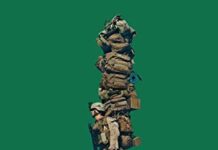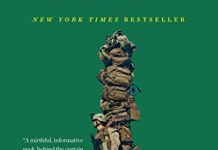
Ebook Info
- Published: 2016
- Number of pages: 201 pages
- Format: Epub
- File Size: 0.79 MB
- Authors: Mary Roach
Description
Grunt tackles the science behind some of a soldier’s most challenging adversaries—panic, exhaustion, heat, noise—and introduces us to the scientists who seek to conquer them. Mary Roach dodges hostile fire with the U.S. Marine Corps Paintball Team as part of a study on hearing loss and survivability in combat. She visits the fashion design studio of U.S. Army Natick Labs and learns why a zipper is a problem for a sniper. She visits a repurposed movie studio where amputee actors help prepare Marine Corps medics for the shock and gore of combat wounds. At Camp Lemmonier, Djibouti, in east Africa, we learn how diarrhea can be a threat to national security. Roach samples caffeinated meat, sniffs an archival sample of a World War II stink bomb, and stays up all night with the crew tending the missiles on the nuclear submarine USS Tennessee. She answers questions not found in any other book on the military: Why is DARPA interested in ducks? How is a wedding gown like a bomb suit? Why are shrimp more dangerous to sailors than sharks? Take a tour of duty with Roach, and you’ll never see our nation’s defenders in the same way again.
User’s Reviews
Mary Roach is the best-selling author of Stiff, Spook, Bonk, and most recently, Packing for Mars. Her writing has appeared in Salon, Wired, Outside, GQ, Discover, Vogue, and the New York Times Magazine. –This text refers to the audioCD edition. Amazon.com Review An Amazon Best Book of June 2016: It takes a special kind of writer to make topics ranging from death to our gastrointestinal tract interesting (sometimes hilariously so), and pop science writer Mary Roach is always up to the task. In her latest book, Grunt, she explores how our soldiers combat their non-gun-wielding opponents–panic, heat exhaustion, the runs, and more. It will give you a new appreciation not only for our men and women in uniform (and by the way, one of the innumerable things you’ll learn is how and why they choose the fabric for those uniforms), but for the unsung scientist-soldiers tasked with coming up with ways to keep the “grunts” alive and well. If you are at all familiar with Roach’s oeuvre, you know her enthusiasm for her subjects is palpable and infectious. This latest offering is no exception. –Erin Kodicek, The Amazon Book Review –This text refers to an alternate kindle_edition edition. From School Library Journal Roach does it again. Amid all the debates about the military-industrial complex in our country, its impact on medicine, invention, and other scientific pursuits is often overlooked. Roach interviews those in science-related military careers, employing her cockeyed sense of humor and awing readers with what she uncovers. (http://ow.ly/PN4C305MyAa)—Jamie Watson, Baltimore County Public Library –This text refers to an alternate kindle_edition edition. Review “A mirthful, informative peek behind the curtain of military science.” ― Washington Post”From the ever-illuminating author of Bonk and Stiff comes an examination of the science behind war. Even the tiniest minutiae count on the battlefield, and Roach leads us through her discoveries in her inimitable style.” ― Elle”Our most consistently entertaining science journalist…Roach goes where other writers wouldn’t dare….And her search produces images―a kind of technopoetry―that are hard to forget.” ― O Magazine”[Roach] takes on the challenges the military faces to keep its fighters safe and healthy with her trademark flair (and zingy footnotes).” ― Entertainment Weekly”Roach is a tenacious investigative journalist with an appetite for the unappetizing…Grunt ranks high in the Roach repertoire.” ― USA Today”Mary Roach’s latest bit of brilliance….As meticulously researched, beautifully written, and disturbingly funny as her previous books…Grunt examines the science behind war, as well as the researchers who are leading the charge in these state-of- the-art developments. Roach’s prose is a triumph―an engaging blend of anecdote, research, and reflection.” ― Boston Globe”[Roach] writes exquisitely about the excruciating….wildly informative and vividly written” ― Los Angeles Times”Nobody does weird science quite like [Roach], and this time, she takes on war. Though all her books look at the human body in extreme situations (sex! space! death!), this isn’t simply a blood-drenched affair. Instead, Roach looks at the unexpected things that take place behind the scenes.” ― Wired”Roach…applies her tenacious reporting and quirky point of view to efforts by scientists to conquer some of the soldier’s worst enemies.” ― Seattle Times”Extremely likable…and quick with a quip….[Roach’s] skill is to draw out the good humor and honesty of both the subjects and practitioners of these white arts among the dark arts of war.” ― San Francisco Chronicle”Covering these topics and more, Roach has done a fascinating job of portraying unexpected, creative sides of military science.” ― New York Post –This text refers to an alternate kindle_edition edition. Read more
Reviews from Amazon users, collected at the time the book is getting published on UniedVRG. It can be related to shiping or paper quality instead of the book content:
⭐ This was a great book. Seriously.I’ve got 25 years military, nine deployments, in both the Marine Corps and the Army National Guard. I’ve worked as an avionics technician on jet aircraft, and also been a platoon sergeant in an infantry unit. I’m no special forces, am definitely middle speed and semi-drag (if you’re military, you understand), but, like I said, I’ve got a lot of experience in the military and the crazy machine that it is.This book doesn’t shy away from that crazy machine. It illustrates in beautiful, tragic, humor, the oddities of the science at work in the military. Our culture and way of doing things is often our own worse enemy. We fight our own plans and circumstances more than we ever fight the enemy.Yet this book isn’t about attacking the military at all. No, don’t misunderstand me. I felt loved, reading this book. It looked at things, many of which in this book I can relate to directly, and showed it to me as one might show a sibling a funny photograph they took of a slightly embarrassing moment, but only to highlight the thing itself and also how much the sibling is loved.If you’re someone who works with anyone in the military and would like an inkling into their experiences and mindset, but would rather skip the politics and such, then this book is for you. Though, warning, the last chapter, which is very short, tore at my heart. If you’re in the military, especially a leader, you should read this book and know that your asinine scheduling of a training exercise is just plain dumb and doesn’t do anything but make people hate you.Wonderful book. And to the author, if you’re ever in Oregon, I’d like to buy you a beer for such a good read and the respectful manner you portrayed my brothers and sisters in arms. I was able to laughed at myself in these pages, and yet paused to wonder if I could perhaps do a little bit better job.
⭐ There’s something seriously wrong with Mary Roach. Conjure up any vile, disgusting, or taboo subject that anyone in her right mind would shun — and you’ll find Mary Roach has written a book about it (or is probably planning to do so). Her books to date have dealt with cadavers, the afterlife, surviving interplanetary flight, the physics and chemistry of sex, and the human digestive (and excretive) tract. And she is not inclined to use circumlocutions. She calls crap crap. I love this woman!Military science under the microscopeNow, in Grunt, her latest book, Roach has turned her attention to military science, specifically the science-based efforts by the U.S. defense establishment to clothe, train, armor, and heal our soldiers, sailors, and airmen and protect them from every manner of wound and loss of function. Unfamiliar and uncomfortable topics such as battlefield hearing loss, shark repellent, bird strikes on airplanes, diarrhea, and penis implantation figure in the story. (The only major topic she avoids is PTSD, because, she writes, “it has had so much [coverage], and so much of it is so very good.”) Roach tells her tale with brutal honesty — and leavens it with an abundance of humor. Some passages are laugh-out-loud funny. Maybe what’s wrong with Mary Roach is that her sense of humor is so much better developed than it is in the rest of us. In any case, I love what she writes.Surprises galoreUnless you are remarkably knowledgeable about the U.S. military, you’re likely to learn a great deal about how it actually works by reading Grunt.*** Consider, for example, the years-long investigation carried out by the Bird Aircraft Strike Hazard (BASH) team of the United States Air Force. You’ll learn why shooting chickens out of a sixty-foot “chicken gun” at 400 miles per hour to test their impact on aircraft in flight was eventually deemed unsuitable. The scientists shifted to turkey vultures. As Roach informs us, “Though implicated in only 1 percent of Air Force birdstrikes, the weighty raptors are, by one accounting, responsible for 40 percent of the damage.” Serious people actually spent years figuring all this out!*** You’ll learn why the Army’s clothing designers crafted custom-designed tops for snipers, with pockets on the sleeves for easy access, a zipper on the side instead of the front, and no buttons, so that when lying on the ground or crawling across it their buttons won’t catch or the zipper make noise that might give away their position. (FYI, “US government button specifications run to twenty-two pages. This fact on its own yields a sense of what it is like to design garments for the Army.”) Can you imagine any army, anywhere else in the world, that would go to such lengths to outfit its troops? “In a place like Afghanistan,” Roach writes, “sweat keeps more people alive than corpsmen do.” The explanation (in Chapter 7) is fascinating.You get the point. Military science can be fun — at least, reading about it can.About the authorMary Roach has written eight books of science journalism. Her work has garnered several awards and been shortlisted for many more. Her books have been bestsellers from the start, beginning with her first effort, Stiff: The Curious Lives of Human Cadavers.
⭐ This is the third book I’ve written by Mary Roach (the others being ‘Bonk’ and ‘Packing for Mars’) and is my favorite so far. In this book Roach covers the science and technology of keeping soldiers safe and effective in war – sometimes (oftentimes) conflicting goals. [Note: In the interest of brevity, I refer to “soldiers” or “Marines” in this review interchangeably for all the military – yes, I know they refer to different branches of the military.]Some of the topics are how to protect soldiers from IEDs when riding in troop carriers; the effect of noise on soldiers; training for medics; treatment of genital mutilation as a result of battle; diarrhea; shark repellent; and the effect of irregular sleep patterns for submariners.A big problem in battle is the kicking in of the “fight or flight response” which makes one “fast, strong, and dumb”; [Loc 1294] while this response kept primitive man alive “when threats took the form of man-eating mammals, when hurling a rock superhumanly hard or climbing a tree superhumanly fast gave you the edge that might keep you alive.” [Loc 1294] “The technical term for f***in’ tunnel vision is attentional narrowing. It’s another prehistorically helpful but now potentially disastrous feature of the survival stress response. One focuses on the threat to the exclusion of almost everything else.”[Loc 1378] This can be a problem for a medic trying to help a Marine in the middle of battle. The resulting reduction of fine motor skills is a big problem for medics who are working with the “growing sophistication and miniaturization of medical equipment.” Add to this the motions and vibrations of a medevac flight, and you start to gain an appreciation for the military medic’s challenges.” [ Loc 1294] Of course the military has a way of training medics to deal with this – which she takes part in and describes.Mary Roach sticks up for scientists’ contributions to the military. When talking about a Sergeant supporting the needs of platoon; she argues that s/he needs to have a wealth of information. “I agree that squad leaders are in the best position to know what and how much their men and women need to bring on a given mission. But you want those squad leaders to be armed with knowledge, and not all knowledge comes from experience. Sometimes it comes from a pogue at USUHS who’s been investigating the specific and potentially deadly consequences of a bodybuilding supplement [which is used A LOT in the military] Or an army physiologist who puts men adrift in life rafts off the dock at a Florida air base and discovers that wetting your uniform cools you enough to conserve 74 percent more of your body fluids per hour.”[Loc 1705]Through it all Mary writes with her trademark dry wit. When discussing the impact of diarrhea on soldiers she talks about the venue for discussing the topic at lunch after training: “The tables in the hangar-size Dorie are arranged church-basement-style, in log rows, so there’s always a friendly stranger across from you or at your elbow, someone new with whom to chat about loose bowel movements while you eat.”]Loc 1772]Mary Roach usually keeps a distance from her subject (and subjects) through her irony and dry wit. But what I especially like about this book is her warmer approach to the people she is writing about; while still keeping her humor. Humor can be used to keep a subject at arm’s distance; but here, she is bring them closer. “I’m adjusting to the concept of a ‘casualty collection point,’to the horrible fact that there can be enough casualties for a ‘collection’.”l [Loc 1660]All-in-all this is my favorite of her books I’ve read. She brings her standard approach of tireless and detailed analysis of how science and technology is applied to critical elements of our lives.”
⭐ I have never met a Mary Roach book I haven’t enjoyed. She exemplifies the kind of science writing I’d love to see be the norm in high schools and even undergraduate studies. Not just for the irreverent style that follows the perpetual openings to ‘go there’ into fart jokes and potty mouth, the need to pursue details about diarrhea and underpants. What I love best is the deeper philosophy behind Roach’s work, the persistent mystery of the human body and how we constantly need to examine it further to understand its complexities, especially when we require it to perform well amidst a lifestyle that increasingly works against it, whether that lifestyle involves nutritional needs or traveling to Mars and back. And I also love Roach’s profound respect for and curiosity about the people who dedicate their lives to this kind of study. As much as her own writing shows her own commitment, she freely confesses to being a voyeur of sorts, who gets to delve into the mire of biology but gets to step away and move on to the next subject. She clearly admires those who persist for years in the topics she only has to write a few pages on.Her latest, clearly, focuses on the efforts behind the military machine. More importantly, the efforts to meet the concerns of warfare and the concerns of the bodies that move that war machine. Whether it be concerns about body armor, genital injuries or sleep cycles on submarines, Roach gets in with the scientists and the soldiers involved to not only divulge the subject itself but spotlight the people involved. What the problem is is as much a focus as Who is working on it. Scientists who mix their metaphors or who can work unfazed by the pounding of bombs nearby. She gets fascinated by the minutiae necessary to this line of work. How to convince a Navy SEAL that anti-diarrheals aren’t the coward’s way out of a problem? Roach gets deep into the muck of daily soldiering and the problems of BO that come up along the way.This isn’t my favorite of her books, as it gets rather episodic under its own banner and doesn’t carry the kind of genius narrative arc like her books Stiff and Packing for Mars did, that by learning about the use of cadavers in medical science or the concerns involved in a manned Mars mission we are learning about the human condition itself, but who can expect that kind of genius in every book? Even Dostoevsky had to admit not every book could be a Brothers K. Roach is case and point that the pursuit of science is at its heart another form of the humanities.
⭐ When most people think of the military, be it the Army, Navy, Marines, Air Force or the Coast Guard, a mental image of soldiers at war comes to mind. There is, however an entirely different side to the military that few even see. It is what goes on behind the scenes that makes the military operate. From the lowly uniform, to high tech machines, to feeding thousands of men: all are necessary to make the modern military operate properly.The author, Mary Roach, takes us behind the scenes to places such as the Army Natick Labs where much research is done into numerous items. They test camouflage, fabric, meals and numerous other items to see if they are suitable for use in the Army. She also visits the Groton. Ct submarine testing center to see how submariners are taught how to survive various emergencies. And, she deals with subjects such as noise, which as you can imagine, is a huge problem in the military.The book is a fascinating look into the back room operations of the military. With her usual bizarre sense of humor, Roach makes the journey entirely pleasurable and interesting. A wonderful read that can be enjoyed by all!
⭐ This is a well written and surprising book. One thinks based on the title that you will be immersed in tales of grunts to find oneself immersed in science topics associated with them. Scientific study of wounds, their impact long term on people, the effects of heat, hearing loss due to military noise, and many other topics. One would not think it as readable as Ms. roach makes it, or as humorous. She also gets some zingers in at shortsighted military policies that negatively impact service members and their families.Need a good book? Here is a doozy!
⭐ This book was just okay because I was hoping for something other than a medical dissertation on a lot of subjects. With that said, the author made it very clear from the beginning what kind of book she wrote. Kudos to her for being honest. I just wish I could have read that ‘disclaimer’ before I purchased the book. Nonetheless, most of what I read – I already knew considering I was a Spec Ops guy in the Marines for 12 years. What impressed me is the author captured the truth but I also know there is much more that she probably learned but can’t publish. That’s just the way it is and I am perfectly okay with it! BTW – the chapters about flies, intestinal issues etc. – is absolutely the truth!
⭐ For those not familiar with Mary Roach, she should probably best be known as the queen of scientific minutia. She’s written popular-level books on the digestive system, sex research, space travel, corpses, specters, space travel, and now she does it again with Grunt, a book which explores the often marginalized aspects of military science. There’s not much talk of planes, tanks, or guns, but you’ll be surprised by how a talented writer like Roach makes gastrointestinal health and nasal warfare just as interesting.Maybe it’s obvious that I’m a big fan of Roach. I’ve read all her books, and I’ve never been disappointed. With her breezy style of writing, Grunt is in the same vein as her other work. But even for those not familiar with her, anybody who has even a hint of scientific curiosity will enjoy this book; doubly so for those who have a history with the military.But really, who isn’t interested in how people are rescued from sunken submarines? And who could turn away from a chapter subtitled, Diarrhea as a Threat to National Security? Really, there’s only one chapter that made me a bit squeamish – yes, the one about penile reconstructive surgery – but the book is a great read nonetheless. More than anything, I’m upset that I’ll have to wait 2-3 years until she finishes her next book.
⭐ This is the perfect beach or airplane read. You’ll learn, you’ll laugh, and you’ll have new respect for our armed forces. This book tells you more about the science and technology of protecting and clothing our troops than you ever imagined or wanted to know – but then when you read it, you’ll say wow is that interesting. You will also come away with an even greater appreciation for what our armed forces have to face every day they are out there laying their lives on the line for us all. Mary Roach is a master of imparting technical information in an easy to digest format, and plus on top of plus, she’s very funny. While learning, you’ll get a chuckle and at times a laugh out loud every page. I read the book in two days and wish there were more of it. I await her next offering. The most enjoyable book I’ve read all summer.
⭐ I think this is my second favorite book of Ms. Roach’s (the first being “Stiff”). Really interesting stuff about our military. In the acknowledgements she stated how surprised she was at the cooperation she got, I have to agree with her surprise but it is also encouraging. From submarines to the desert of Afghanistan she takes us on yet another fascinating journey.
Keywords
Free Download Grunt: The Curious Science of Humans at War in Epub format
Grunt: The Curious Science of Humans at War Epub Free Download
Download Grunt: The Curious Science of Humans at War 2016 Epub Free
Grunt: The Curious Science of Humans at War 2016 Epub Free Download
Download Grunt: The Curious Science of Humans at War Epub
Free Download Ebook Grunt: The Curious Science of Humans at War





